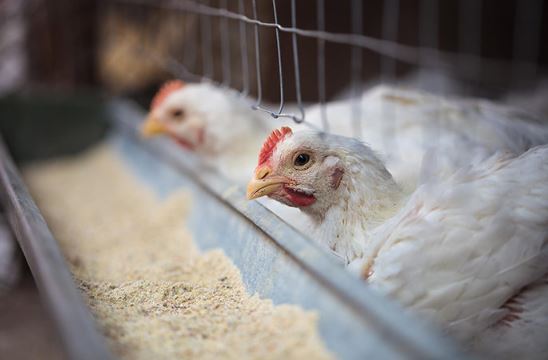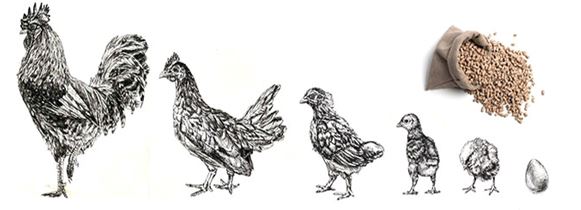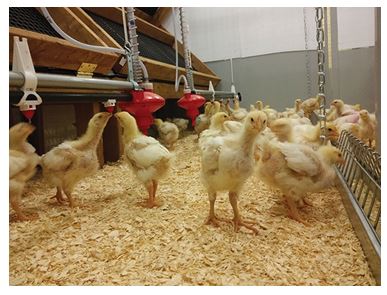
Introduction
It is a method of feeding where time, duration and amount of feed are limited. There actual reduction of nutrient intake below minimum requirement. Several types of feed restriction programmers can be followed during the growing period of breeders specially broiler breeders, usually from 6- 20 weeks of age. Some of the common methods are: restriction on quantity i.e. Feed intake, restriction of feeding time, restriction of a nutrient, like protein or energy, skip-a-day programme and, alternate day feeding programme.

Different feeding systems for feeding of poultry are:
- Ad Libitum Feeding-this system is also called free choice feeding. In this system feed is always available and the bird can eat at will.
- Forced feeding- forced feeding may be employed if feed and water are denied for more than 36 hours to prevent body dehydration.
- Phase feeding-followed during lying phase.
- Restricted feeding
Restricted feeding
It is the method of feeding where time, duration and amount of feed are limited. There actual reduction of nutrient intake below minimum requirement. Allowing birds an unlimited supply of feed may result in heavy over consumption. The birds are liable to consume too much energy and this will be converted into body fat which in turns leads to a higher maintenance requirement. Restricted feeding is necessary if the birds are going to be used as breeder stock. The obesity severely limits the numbers of eggs laid and the fertility of eggs, mortality may be increased. Not practiced during disease.
There are two types of restricted feeding
- Quantitative feed restriction- In which the amount of feed is reduced below the normal requirement of birds. This can be done on day-to-day basis or skip-a-day programme or skip-two days in a week programme. But this restriction depends on the matching of the flock average body weight with standard body weight provided by the breeder. Quantitative feed restriction is usually followed in commercial breeders.
- Qualitative feed restriction-In which the quality of the feed is reduced below the standard requirement of the bird. This can be done by including unconventional feeds or lesser nutrient feed ingredients in place of high protein or high energy diet. Here the quantity of allotment to the bird is not restricted.
Ways for restricted feeding
Water Restriction-with broiler breeder pullets and cockerels on restricted feeding programs, water should be turned on and available for one hour prior to feeding and turned off or removed one hour after all feed is consumed. If a skip-a-day feeding program is used, water should also be available for approximately two hours on the non-feed day.

- Physical Feed Restriction: Supply a calculated amount of feed per bird, which is often just enough to meet maintenance requirements. It is necessary to provide sufficient feeder space in order to prevent competition among restricted birds and to prevent unequal growth of birds within a flock.
- Diet Dilution: In this method diets are mixed with non-digestible ingredients such as fiber and so are of reduce nutrient density. Dilution with rice hulls in order to retard early growth. Reduced body fat deposition.
- Lighting Programs: Birds are very sensitive to light .Light intensity, color and the photoperiodic regime can affect the physical activity of pattern within a flock. Poultry under different reduced lighting programs will reduce their feed.
Benefits of Feed Restriction:
- Restricting feed intake of growing birds will delay the onset of sexual maturity from a few days to 3 or 4 weeks, depending on the severity of restriction.
- Feed restriction of a flock will reduce the body weight of the birds at sexual maturity, usually by reducing the amount of body fat.
- Mortality during the growing period is reduced when feed is restricted.
- Restricting feed intake reduces the cost of growing pullets to sexual maturity, even though it may take three additional weeks before first eggs are laid.
- Restricting the feed intake during the growing period produces better livability during egg production.
- Egg weight is regulated by the age of the bird. Therefore, birds reared using feed restriction will produce larger first eggs because they are older.
Pullet feed program –
The breeder starter should be fed the first 2 to 3 weeks. It is to be full fed the first 2 weeks, then restricted during the third and fourth weeks, but fed every day. on the average, full-fed broiler breeder pullets should be eating about (4 kg) of feed per 100 pullets per day at 14 days of age.
Restricted feeding program breeder cockerels
Meat-type cockerels, to be used as broiler breeders, have standard weekly weights, and it is just as important that male weights be maintained as the weights of the growing pullets. To get these weights, the cockerel-growing feed must be restricted. At 24 weeks of age the males should average about 35% heavier than the females.
There are four broiler breeder rearing and feeding programs-
- Cockerels separate upto 28 to 42 days.
- Cockerels separate upto 10 weeks.
- Cockerels separate upto 20 to 22 weeks.
- Feeding in blackout houses.
Cockerels separate upto 4-6 weeks
Coming from small eggs, small meat-line cockerel chicks should be started within guards under separate brooders using the same feed and feeding program for the cockerels and pullets. The earliest that cockerels should be mixed with pullets is 28 days and the cockerels should be at least 40% heavier than the pullets. Broiler breeder males should not be fed low-protein diets to reduce weight, particularly before 8 weeks of age, as such a practice reduces fertility later.
Cockerels separate upto 20 to 22 weeks
In this program was the best of all growing programs; growth rate of each sex could be accurately controlled by feed allocation. Male aggression can be quite high using this program and so it is advisable to place some a-frame perches in each pen to allow the males to escape. at 20 to 22 weeks of age, move the cockerels with the pullets to the production house.
Feeding in blackout houses
With this program the sexes are generally raised in separate houses that are environmentally controlled with forced-air ventilation, cooled, and capable of being fully blacked out. Full feed males an 18 to 20% protein starter for four weeks. The males should continue on a starter diet until they are 6 weeks of age but a skip-a-day program should be started during the 5th week. Males should be fed a pullet grower diet at 6 weeks of age. This program will induce chicks hatched out of season to come into egg production earlier, resulting in smaller eggs at the start of production.
Conclusion
Among all these methods which can be followed in the birds which are being reared. Each method has certain advantages and disadvantages and none can be regarded as best suited under all conditions. The choice of a feeding system would depend upon the age of the birds, relative cost of mash and grains the amount of time and labor available. Several advantages like reduced cost of feeding, delayed sexual maturity, better egg production curve, reduction in the number of small eggs laid, have been claimed for this method.

Priyanka Bhandari
M.V.Sc.Scholar
Department Of Animal Nutrition, College Of Veterinary and Animal Sciences, GBPUAT, Pantnagar, US Nagar, Uttarakhand-263145
*Corresponding Author mail id: – pb65924@gmail.com

Anshu Rahal
Associate Professor
Department Of Animal Nutrition, College Of Veterinary and Animal Sciences, GBPUAT, Pantnagar, US Nagar, Uttarakhand-263145



























